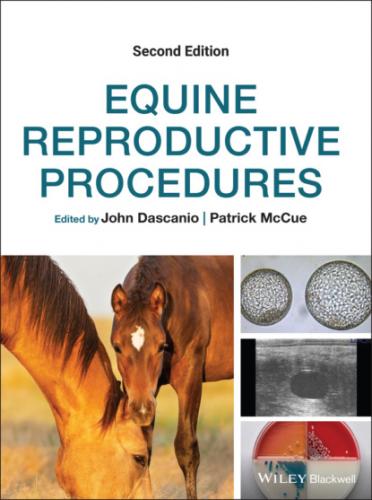Additional Comments
Foreign bodies, such as a marble or the tip of a culture instrument, are easily visualized with an endoscope (Figures 20.7 and 20.8). Videoendoscopy can also be used to deposit a small volume of concentrated spermatozoa at the UTJ as part of a low dose, deep horn insemination protocol. Laser ablation and other types of management of endometrial cysts are also performed using an endoscope. Finally, videoendoscopy can be used to facilitate cannulation of the UTJ to flush the oviducts of mares suspected of oviductal blockage (see Chapter 32).
Figure 20.8 Tip of a uterine culture instrument in the uterine lumen viewed by an endoscope.
Further Reading
1 Bracher V, Allen WR. 1992. Videoendoscopic evaluation of the mare’s uterus: I. Findings in normal fertile mares. Eq Vet J 24: 274–8.
2 Bracher V, Mathias S, Allen WR. 1992. Videoendoscopic evaluation of the mare’s uterus: II. Findings in normal fertile mares. Eq Vet J 24: 279–84.
3 Card CE. 2011. Endoscopic examination. In: McKinnon AO, Squires EL, Vaala WE, Varner DD (eds). Equine Reproduction, 2nd edn. Ames, IA: Wiley Blackwell, pp. 1940–50.
4 Inoue Y, Sekiguchi M. 2018. Clinical application of hysteroscopic hydrotubation for unexplained infertility in the mare. Eq Vet J 50: 470–3.
5 Lindsey AC, Morris LHA, Allen WR, Shenk JL, Squires EL, Bruemmer JE. 2002. Hysteroscopic insemination of mares with low numbers of nonsorted or flow sorted spermatozoa. Eq Vet J 34: 128–32.
6 Rambags BPB, Stout TAE. 2005. Transcervical endoscope‐guided emptying of a transmural uterine cyst in a mare. Vet Record 156: 679–82.
21 Endometrial Cyst Removal
John J. Dascanio
School of Veterinary Medicine, Texas Tech University, USA
Introduction
Endometrial or uterine cysts may be glandular or lymphatic in origin and may range from a few millimeters to as large as 20 cm. The presence of cysts usually indicates a degree of uterine pathology, with affected mares having an increase in uterine biopsy score due in part to increased fibrosis. Cysts may have a negative effect on fertility due to prevention of embryo migration, thus interfering with maternal recognition of pregnancy, interference with early embryonic histotroph absorption, and interference with placentation. Removal of cysts that are large in size or multiple in number may have a positive effect on fertility. Removal of cysts has been described using a snare, laser hysteroscopy, loop cautery, or uterine biopsy instrument. Uterine lavage and infusion of intrauterine antibiotics may be performed after cysts are removed.
Equipment and Supplies
Tail wrap, non‐irritant soap, roll cotton, stainless steel bucket, disposable liner for bucket, paper towels, exam gloves, flunixin meglumine, sedatives, artificial insemination pipettes, No. 3 polyamide suture material, tape, sterile uterine biopsy instrument, obstetrical sleeve, sterile obstetrical lubricant, endoscope, gluteraldehyde disinfectant, chlorhexadine solution, sterile saline, laser fibers, electrocautery unit, loop cautery fiber.
Techniques
General Preparation
Remove feces from the rectum and document the size and location of each endometrial cyst using transrectal ultrasound (Figure 21.1).
Place a tail wrap and tail rope onto the mare (see Chapter 4).
Wearing examination gloves, clean and dry the perineum of the mare (see Chapter 3).
The mare is usually sedated using a combination of xylazine (0.33–0.44 mg/kg IV) or detomidine (0.0088–0.011 mg/kg IV) plus butorphanol tartrate (0.011–0.022 mg/kg IV).Figure 21.1 Two ultrasound images of endometrial cysts of 2.5 and 2.6 cm diameter in a mare.
Flunixin meglumine may be administered (1.1 mg/kg IV) to minimize the inflammation caused by removal of the cyst(s).
Snare Removal
The mare should be in estrus so that the cervix is dilated to allow passage of a small hand into the uterus.
Large endometrial cysts that are pedunculated (lymphatic cysts) may be removed using a snare technique.
A snare is fashioned using two artificial insemination pipettes attached together side by side using tape. No. 3 polyamide suture material is threaded through the end of one pipette and back into the other pipette so that there is a loop going between the two pipettes (Figure 21.2). The length of the suture material should be 3× the length of the pipettes.
Cold sterilize the snare apparatus in dilute chlorhexidine solution (approximately 12 ml chlorhexidine in 500 ml sterile saline) for 15 minutes and rinse with sterile saline.
Place a sterile obstetrical sleeve on one arm and place sterile lubricant on the back of the gloved hand and down the sleeve.
With the gloved hand, the end of the snare apparatus is passed through the cervix into the uterus and the loop is fitted around the base of the pedunculated cyst. Cervical dilation may be achieved with slow constant pressure with the hand in a mare in estrus.
The loop is tightened by pushing the pipettes inward against the pedicle of the cyst while pulling outward on the suture material.
The suture material is subsequently moved back and forth to cut through the cyst stalk and the cyst is then removed by hand (Figure 21.2).
Figure 21.2 Lymphatic cysts removed using a snare. The snare is to the right of the cysts.
Endoscope Preparation
The mare should be in diestrus, with a closed cervix, to allow insufflation of the uterus for visualization.
Cold sterilize a 1 m long, 11 mm diameter endoscope in an activated solution of 2.4% glutaraldehyde (Cidex®) and rinse thoroughly with sterile saline making sure to properly clean and rinse the accessory channel.
Place a sterile obstetrical sleeve on one arm and hold the end of the endoscope in this gloved hand. A second operator will be necessary to work the endoscope controls.
Place
